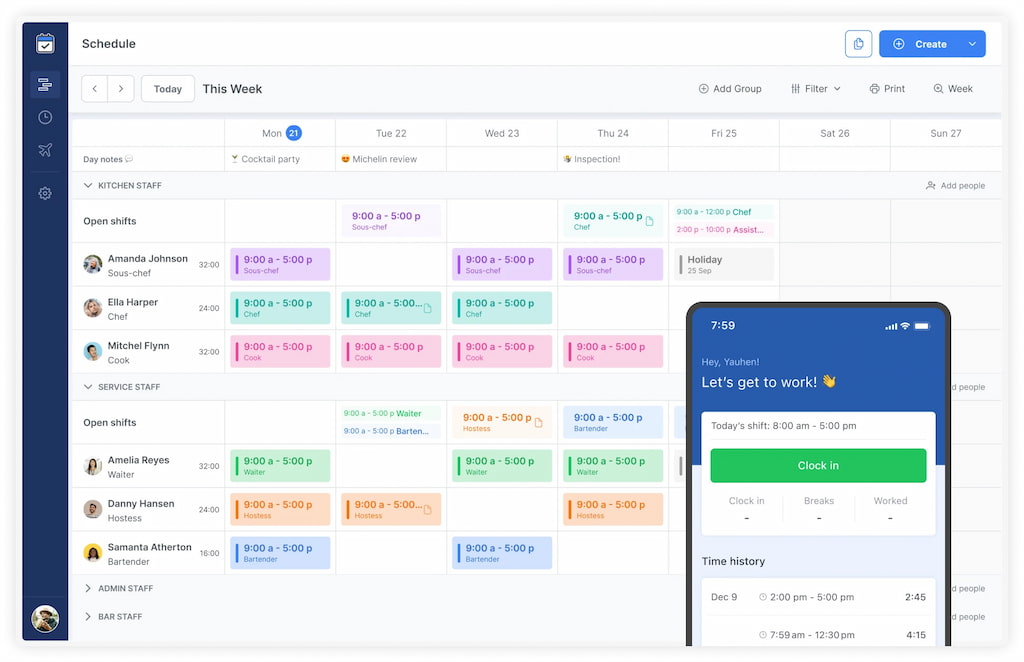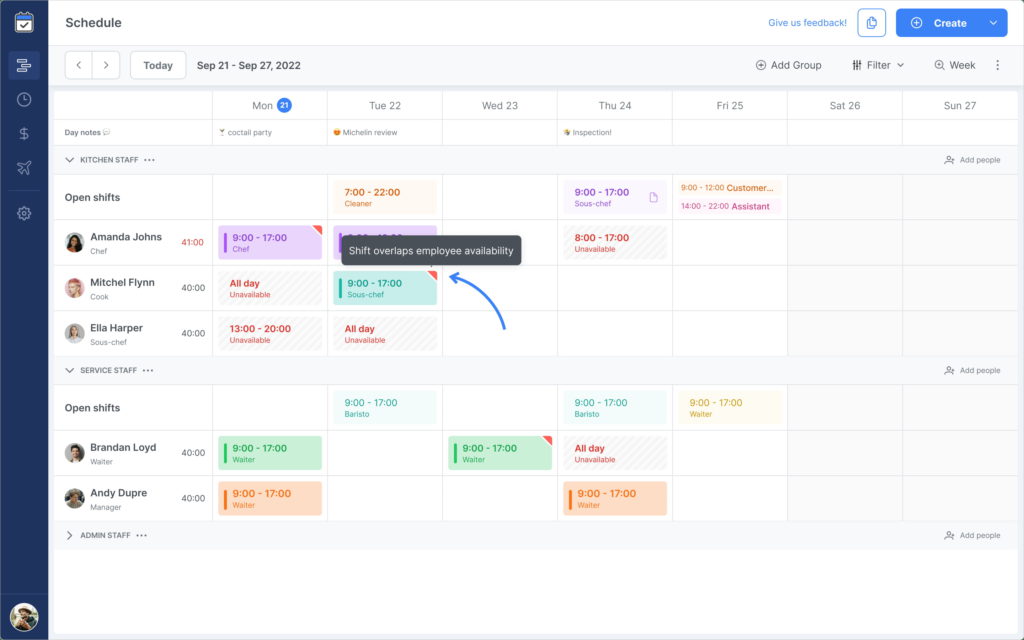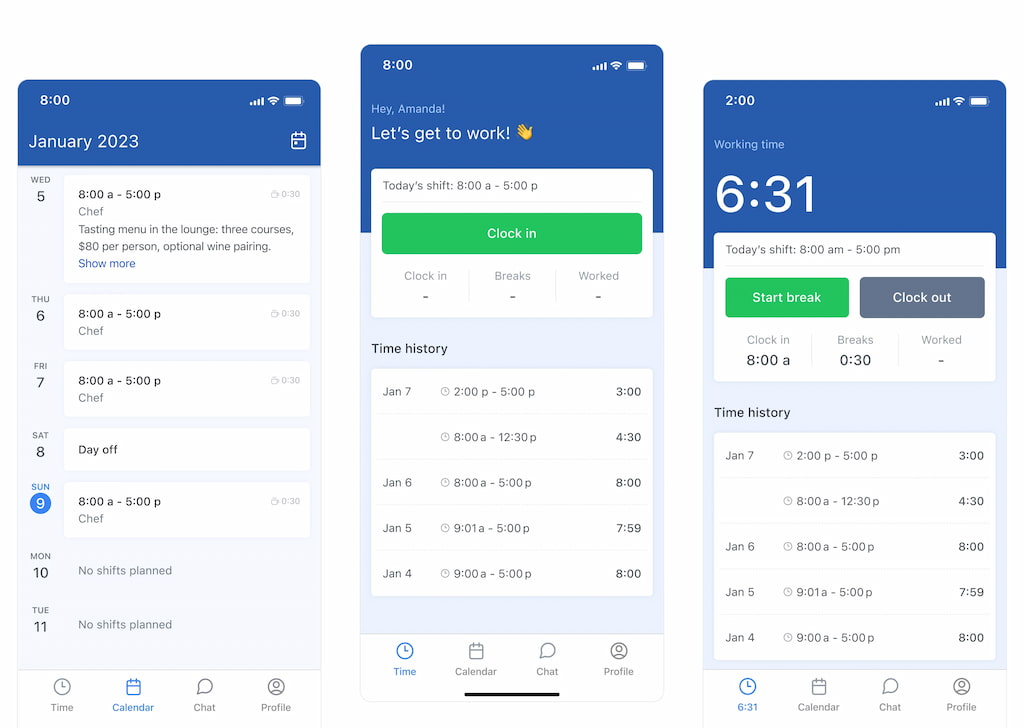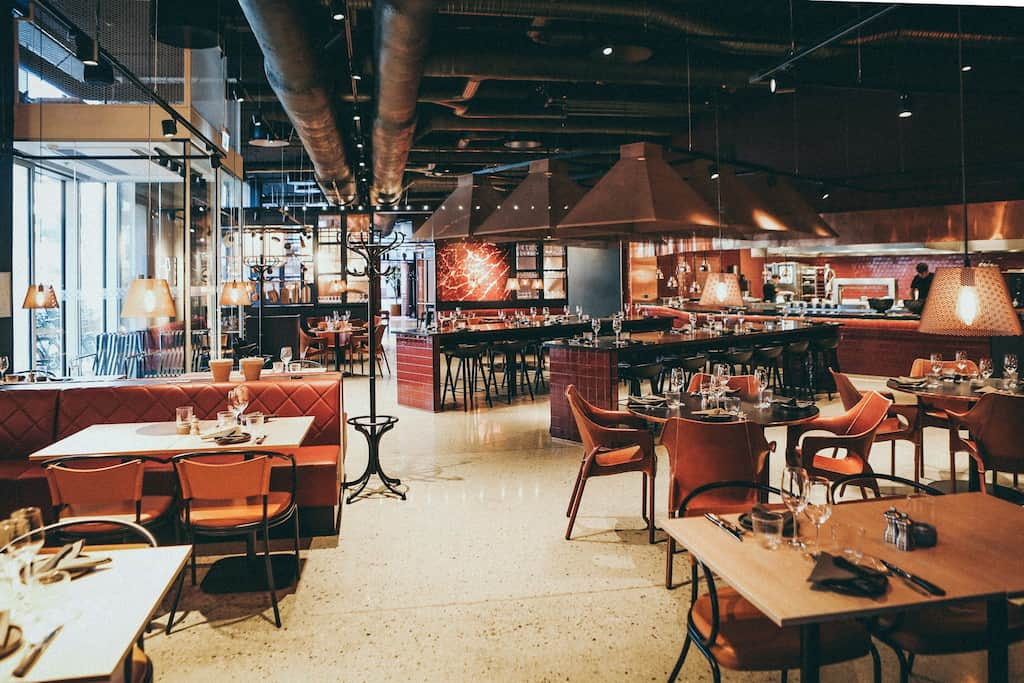Creating a restaurant employee schedule is essential for smooth operations and proper staffing. This guide shares practical tips and strategies to make scheduling easier. We’ll cover everything you need to know to create a restaurant employee schedule that meets the needs of your business and staff. We’ll learn the best practices for restaurant staff scheduling. So let’s explore how to make a restaurant employee schedule that works for everyone. (Don’t forget to leverage free employee shift scheduling apps)!
How Can Restaurant Staff Schedule Help Your Business
A well-crafted restaurant staff schedule can significantly benefit your business in several ways:
💼 Optimized staffing levels: Ensure you have the right number of employees working during peak hours.
📈 Improved efficiency: Streamline operations and reduce downtime, thus leading to faster turnover.
😊 Enhanced customer experience: The right schedule for restaurant staff provides better service.
💰 Cost savings: Effective scheduling for restaurants can also help avoid unnecessary overtime.
👩💼 Employee satisfaction: A transparent scheduling process can boost employee morale and engagement.
How to Build a Restaurant Employee Schedule
Building a restaurant employee schedule requires careful planning to ensure optimal staffing levels. Here are some steps to help you create an effective schedule:
1. Assess your needs
Begin by evaluating your restaurant’s busy periods, slow times, and specific staffing requirements for each shift. Consider factors such as peak dining hours, special events, and seasonal fluctuations in business.
2. Gather employee availability
Collect availability information from your staff. Include their preferred working hours, days off, and any scheduling constraints they may have. Use this information as a basis for building your schedule.
3. Create a staffing matrix
Develop a staffing matrix or template that outlines the required positions and number of employees needed for each shift. This will serve as a guide for scheduling and ensure that you have adequate coverage throughout the week.
4. Use scheduling software
Consider using restaurant staffing schedule software or apps to streamline the scheduling process. These tools can help you track employee availability, automate assignments, and communicate changes.
5. Balance employee preferences
While creating the schedule, try to accommodate employee preferences and requests as much as possible. This can help improve morale and reduce turnover by demonstrating that you value your staff’s needs and preferences.
6. Factor in labor laws and regulations
Familiarize yourself with labor laws and regulations governing employee scheduling, such as maximum hours worked, mandatory breaks, and overtime pay requirements. Ensure that your schedule complies with these regulations to avoid legal issues.
7. Communicate the schedule
Once the schedule is finalized, communicate it to your staff in advance. Provide clear instructions for the employees on how to access schedules. Be responsive to any scheduling conflicts or requests for changes.
8. Monitor and adjust
Once the schedule is finalized, communicate it to your staff in advance. Provide clear instructions for the employees on how to access schedules. Be responsive to any scheduling conflicts or requests for changes.
By taking a proactive approach, you can build a restaurant employee schedule ensures a positive experience for your staff.
Best Tips for Scheduling Employees
1. Prioritize cross-training
Cross-training your staff in different roles and responsibilities can provide flexibility in scheduling. Encourage employees to learn multiple tasks, such as serving, hosting, and cooking. That might enhance their skills and adaptability.
2. Implement rotating shifts
Rotate shifts among your employees to distribute workload fairly and prevent burnout. Avoid assigning the same employees to undesirable shifts consistently. Provide opportunities to work during peak hours.
3. Use predictive scheduling
Consider implementing predictive scheduling practice. Forecast staffing needs based on historical data, sales trends, and other relevant factors. Predictive scheduling can help you optimize labor costs and minimize overstaffing/understaffing.
4. Offer incentives for flexible scheduling
Encourage employees to volunteer for flexible scheduling options by offering incentives. Flexible scheduling helps accommodate fluctuating demand while rewarding employees for their flexibility.
5. Streamline communication channels
Establish clear communication channels for scheduling-related communication. For example, for dealing with shift swaps, time-off requests, and schedule updates. Use scheduling software, messaging apps, or a dedicated scheduling hotline. They will facilitate communication and ensure employees can respond to scheduling-related information.
What to Look for in Restaurant Scheduling Software
🎨 Ease of use: Choose a restaurant staff scheduler with intuitive features. They include drag-and-drop scheduling, customizable templates, and mobile accessibility for on-the-go scheduling.
🤝 Employee management: Opt for restaurant shift scheduling software with features for employee availability, time-off requests, and shift swaps.
📊 Shift coverage: Select software that offers predictive scheduling, labor cost tracking, and analytics.
💳 Integration with Point of Sale (POS) Systems: Choose restaurant shifts scheduling software that integrates seamlessly with your restaurant’s POS system to streamline payroll processing, track employee hours worked, and generate accurate labor cost reports. Integration with other business tools such as payroll software, time clock systems, and employee performance metrics can also enhance efficiency and data accuracy.
📜 Compliance and regulatory features: Ensure the scheduling software complies with labor laws and regulations. Follow minimum wage or overtime laws, and scheduling mandates such as predictive scheduling laws. Look for features such as compliance alerts, labor law updates, and built-in reporting tools.
🚀 Scalability and customization: Select software that can scale with your restaurant as it grows and evolves. Look for scheduling templates, multi-location support, and role-based permissions to adapt to your organizational structure.
🛠️ Support and training: Choose software that offers customer support, training resources, and updates. Look for live chat support, help center documentation, and user forums to troubleshoot issues.
How Can Shifts by Everhour Help with Restaurant Scheduling?
Shifts by Everhour is a restaurant schedule software that ensures optimal workforce restaurant management. Here’s how Shifts by Everhour can help with shift management in restaurants:
Efficient shift creation
With Shifts by Everhour, managers can create and customize shifts based on restaurant needs, including assigning specific roles, shift durations, and start/end times. This ensures that shifts are tailored to meet operational requirements and staffing levels.

Shift assignment and distribution
Shifts by Everhour allows managers to assign shifts directly within the app. Managers can distribute shifts based on employee availability, skills, and preferences. This ensures equitable distribution of workloads and minimizing scheduling conflicts.
Shift swapping and availability management
Employees can use Shifts by Everhour to request shift swaps or indicate their availability for upcoming shifts. Managers are notified of these requests and can approve or decline them.

Real-time shift updates
Shifts by Everhour is a restaurant scheduler that provides real-time visibility into schedules. Managers can monitor employee attendance, track shift changes, and make adjustments as needed. This ensures that managers have up-to-date information on shift coverage and can address any scheduling issues.
Shift reminders and notifications
Shifts by Everhour sends automated reminders about upcoming shifts, ensuring they know of them and arrive on time. This helps cut absenteeism and ensures that shifts are adequately staffed to meet operational demands.
Mobile clock-in/out
Shifts by Everhour offers mobile clock-in/out functionality. This allows retail employees to record their work hours using smartphones or tablets. This ensures flexibility for staff members to clock in and out from any location, whether they’re on the sales floor, in the warehouse, or on break. Real-time updates on attendance enable managers to monitor and make timely scheduling adjustments.

Ready to streamline your restaurant shift management? Try Shifts by Everhour today, learn when and how to manage restaurants, and take your scheduling to the next level!
FAQ Section
1. What is restaurant scheduling?
Restaurant scheduling involves managing employee work schedules to ensure adequate staffing coverage.
2. Why is restaurant scheduling important?
It ensures smooth operations, minimizing labor costs, and delivering excellent customer service. It helps managers allocate resources efficiently and manage labor expenses.
3. What challenges do restaurant managers face when scheduling employees?
- Fluctuating demand
- Dealing with employee availability/preferences
- Minimizing labor costs
- Complying with labor laws
- Unexpected events (employee call-outs or last-minute schedule changes)
4. What are some best practices for restaurant scheduling?
- Forecasting labor needs based on historical data
- Creating schedules that consider employee preferences/availability
- Using scheduling software
- Communicating about schedules
- Regularly reviewing and adjusting schedules based on feedback and performance.
5. How can restaurant scheduling software help streamline the scheduling process?
Restaurant scheduling software automates the scheduling process. It includes employee availability management, shift assignment, time-off requests, and labor forecasting. It helps managers create optimized schedules, track labor costs, and communicate with staff. Additionally, scheduling software can integrate with other restaurant management systems, further streamlining operations.
In case you’re looking for a seamless way to improve shift planning, Shifts by Everhour is the perfect solution. Real-time monitoring, easy scheduling, and mobile accessibility will help manage your team easily.
Conclusion
In conclusion, effective restaurant scheduling is essential for delivering exceptional customer experiences. With the right tools and strategies, restaurant managers can overcome scheduling challenges. To sum up, Shifts by Everhour is the optimal solution. It offers intuitive features, robust shift management capabilities, and seamless integration possibilities. Empower your restaurant with a free work schedule maker to elevate your business to new heights.

